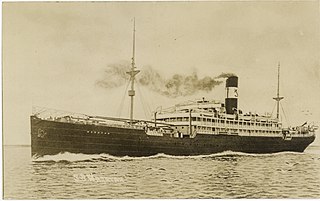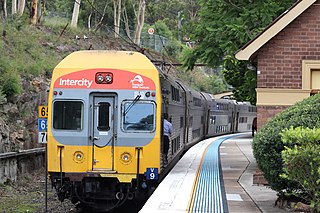
USS Culgoa (AF-3) was a steam cargo liner. She was launched in England in 1889 for Blue Anchor Line, who ran her between England and Australia. In 1898 she was bought for the United States Navy as a stores ship. She served in the Philippine–American War; the Great White Fleet; and the First World War. In January 1909 she took part in the relief operation after the 1908 Messina earthquake. To date, she is the only US Navy ship to have been named Culgoa. In 1922 the United States Department of the Navy sold her to a civilian owner, who renamed her Champlain. She was scrapped in the United States in 1924.

CityRail was a passenger railway brand operated by the State Rail Authority from 1989 to 2003 and by RailCorp from 2003 to 2013 with services in and around Sydney, Newcastle and Wollongong, the three largest cities in New South Wales, Australia. It was established in January 1989 and abolished in June 2013 when it was superseded by Sydney Trains and NSW TrainLink.

The New South Wales Waratahs, referred to as the Waratahs, are an Australian professional rugby union team representing the majority of New South Wales in the Super Rugby competition. The Riverina and other southern parts of the state, are represented by the Brumbies, who are based in Canberra, Australian Capital Territory (ACT).

The City of Canterbury was a local government area in the Inner South-West region of Sydney, New South Wales, Australia. The council area was within the northern part of the Parish of St George above Wolli Creek and The M5 but below The Cooks River. The city was primarily residential and light industrial in character, and was home to over 130 nationalities. With a majority of its residents being born overseas, the council marketed itself as the "City of Cultural Diversity." First incorporated as the Municipality of Canterbury in 1879, the council became known as the City of Canterbury in 1993.

Hereward, was British clipper ship that was built in Scotland in 1877. She had an iron hull, three masts and full rig.

SS Waratah was a passenger and cargo steamship built in 1908 for the Blue Anchor Line to operate between Europe and Australia. In July 1909, on only her second voyage, the ship, en route from Durban to Cape Town along the coast of what is present-day South Africa, disappeared with 211 passengers and crew aboard. No trace of her has ever been found, and her fate remains unknown.

The Blue Mountains Line (BMT) is an intercity rail service serving the Blue Mountains region of New South Wales, Australia. The line travels west from Sydney to the major town of Katoomba and on to Mount Victoria, Lithgow and Bathurst. Mount Victoria is the terminus for most electric services, but some services terminate at Lithgow instead. Two express services per day in each direction, known as the Bathurst Bullet, extend to the regional city of Bathurst, which is supplemented by road coaches connecting Bathurst to Lithgow. Due to electrification limits at Lithgow, the Bathurst Bullet is run using the Endeavour railcars, which operate on diesel. The Blue Mountains Line operates over a mostly duplicated section of the Main Western line. As such, the tracks are also traversed by the Central West XPT, Outback Xplorer and Indian Pacific passenger services and by freight trains.
Group 10 is a rugby league competition in the Central West area of New South Wales, under the auspices of the New South Wales Rugby League. It had been under the control of Country Rugby League but that changed after the NSWRL agreed to a new constitution and the CRL voted to wind up its affairs immediately. The decisions was made on 19 October 2019 and the merger means that the aim of a unified administration of the sport in NSW was achieved over a year ahead of time.

HMAS Bungaree was a cargo steamship. She was built in Scotland in 1937 as Bungaree for the Adelaide Steamship Company of South Australia. The Royal Australian Navy requisitioned her in 1040, and had her converted into a minelayer. She was Australia's only minelayer in the Second World War, and laid more than 10,000 mines. In 1944 she changed rôles, becoming first a survey ship, and then a stores ship. The Navy returned her to her owners in 1947.

Burraboi is a community in New South Wales, Australia. It is in the southwestern part of the Riverina, about 34 kilometres (21 mi) north of Barham and 50 km south of Moulamein. At the 2016 census, Burraboi had a population of 63.

Queen of Nations was a wooden-hulled, three-masted clipper that was built in Scotland in 1861 and wrecked on the coast of New South Wales in 1881. She spent her entire two-decade career with George Thompson, Junior's Aberdeen White Star Line.

Arthur Hill Griffith was a politician, teacher and patent attorney in New South Wales, Australia. He was a member of the New South Wales Legislative Assembly from 1894 until 1917 and held a number of ministerial positions in the Government of New South Wales. He was a member of the Labor Party.
In 2013 Bathurst, New South Wales, Australia celebrated 200 years from its naming as a town in 1813. Over the 200 years significant milestones have occurred in the town and regions infrastructure development to support growth of the region. The development of Australia progressed with a few frontier towns built in extreme isolation like Bathurst. Sydney was founded in 1788 and 25 years later in 1813 only a few other coastal towns had been established. The desire to explore the unknown areas led the Colonial Government to sponsor expeditions to the interior of the vast country. A large mountain range running parallel to the Sydney coast blocked access to the west and rugged mountains and a river blocked access to the north. Before the exploration of the inland started they had no idea what they would find but what they did discover was fertile and well watered land ideal for grazing of animals and producing agricultural products.

SS Barossa was a steam bulk carrier. She was built in Scotland in 1938 for the Adelaide Steamship Company of South Australia. In 1942 she was burnt out in the Japanese bombing of Darwin, but she was raised and repaired. In 1949 she was the focus of a watersiders' strike in Brisbane, which as a result is sometimes called the "Barossa strike".
Frederick William Lund was a British businessman and one of the proprietors of Messrs. W. Lund and Sons, owners of the Blue Anchor Line shipping company.

SS Bungaree was a steam cargo liner. She was launched in England in 1889 for Blue Anchor Line, who ran her between England and Australia. The Quebec Steamship Company bought her in 1903 and renamed her Parima. Furness, Withy & Company took over the Quebec SS Co in 1919. She was scrapped in Italy in 1925.

SS Wakool was a refrigerated cargo liner that was launched in England in 1898. She belonged to Wilhelm Lund's Blue Anchor Line until 1910, when P&O took over the company. She was a troopship in the Second Boer War from 1899 to 1902. In 1913 a Japanese company bought the ship and renamed her Kwanto Maru. In 1914 she was a Japanese depot ship in the siege of Tsingtao. In 1917 the French government bought her and renamed her Le Myre de Villers. The French government sold her in 1923, and she was scrapped in Italy later that year.

Geelong was a ship owned by the Blue Anchor Line, and, after 1910, by P&O. She was built in 1904 by Barclay, Curle and Co. Ltd., at Glasgow, Scotland. As built, she had berths for 120 saloon and 200 third-class passengers, and also carried cargo. Her tonnages were 7,951 GRT and 5,030 NRT) tons, and she was 450.0 feet long, powered by triple-expansion steam engines, and capable of 14 knots, with a cruising speed of 12 knots (22 km/h).
The 1848 New South Wales colonial election was held between 29 July and 2 August. No candidates were nominated for Port Phillip as a result of the campaign for independence from New South Wales, and a fresh writ was issued for an election on 3 October.

























